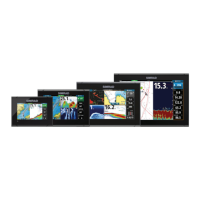settings depend on vessel’s characteristics, loaded/ballast
conditions and rate of turn.
• If the vessel has good dynamic stability, a relatively small value
will be sufficient
• An unstable vessel will require high value
• The greater the vessel’s inertia, the greater value will be required
Increasing counter rudder value may result in some higher rudder
activity also when steering a straight course.
The best way of checking the value of the Counter rudder setting is
when making turns. The following figures illustrate the effects of
various Counter Rudder settings:
1 Counter rudder too low; overshoot response.
2 Counter rudder too high; sluggish and creeping response.
3 Correct setting of counter rudder; ideal response.
Perform various course changes and observe how the boat settles
on the new heading. Start with small changes, 10-20 degrees, and
proceed with bigger changes, 60-90 degrees. Adjust Counter rudder
value to obtain best possible response as in illustration 3.
Ú
Note: As many boats turn differently to port versus starboard
(for various reasons), perform the course changes in both
directions. You may end up with a compromise setting of
Counter rudder that gives a little overshoot to one side and a
bit creeping response to the other.
Auto trim
This parameter defines how fast the autopilot shall correspond after
having registered a heading error.
The standard value is 40 seconds which should work well on most
boats. Rule of thumb: Set to same value (seconds) as the boat’s
50
Software Setup | GO XSE Installation Manual

